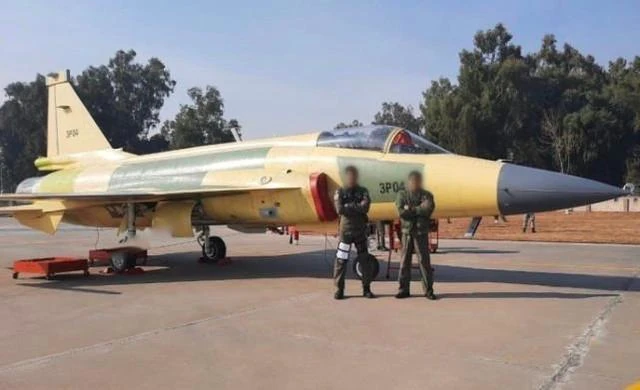Photos of the first mass-produced version of the JF-17 Block III fighter have arrived on social media, suggesting that the model may enter Pakistani service soon. The fighter jets are expected to be produced in China and assembled in Pakistan. Since China does not trust this fighter, even as a cheap replacement for the obsolete J-7’s and J-8’s, the JF-17 fighter jet is explicitly built for export.
Like the previous models of the JF-17, the Pakistan Air Force is expected to be the primary customer for this model. The Chinese feel the new model could attract more interest from foreign customers as it has a substantial increase in the new capabilities. The latest block of JF-17 appears to be a game-changer for the technology starved Pakistan’s air combat capabilities as it advertises integrating limited stealth, a more powerful engine, a bigger KLJ-7A AESA radar, and the first infrared search and track system (IRST) on a Pakistani fighter jet. In addition to the recently announced purchase of the FC-20E, a J-10C look like from China, the JF-17 Block III will also introduce the AESA radar to the Pakistan Air Force, providing enhanced situational awareness and interference immunity from electronic warfare while providing offensive electronic warfare options.
Since the JF-17 is among one of the lightest fighter jets in the world, it has a similar weight to the Swedish Gripen and the US F-16 and can accommodate relatively small radars. Integrating a more advanced radar compensates for the radar limitation.

The light fighters are considered a good fit for Pakistan’s defense budget because of their extremely low cost of operation and maintenance and their high availability and availability rate, which means that the majority of the fleet is ready for combat at any time. However, this low-cost design comes at the expense of flight performance. The fighter is not particularly nimble, which is compensated for by equipping the PL-10E short-range air-to-air missile capable of striking targets at very extreme angles but at a range of about 20 km. This is the primary air to air armament of the JF-17 fighter Block III model.
In addition to improvements in sensors and avionics, the armament of the PL-15 long-range air-to-air missile is considered the most notable feature of the new fighter. The PL-15 has an estimated 200 km range (or more depending upon many factors like release height, angle of attack etc.), far exceeding most of India’s existing air-to-air missiles, such as the 80 km MICA missiles used by the Rafale jets. This missile outranges any missile fielded by the Indian Air Force Mirage 2000 fighter jets and the MiG-21. The MiG-29 and Su-30MKI use the R-77 missile with a range of 110 kilometres. The only exception is the older Novator K-100 missiles of the Su-30MKI, which pose a low threat to fighter jets and are designed to engage large support aircraft at a range of 300 km, and the Meteor missiles purchased for the Rafale fighters with an estimated range of 200 kilometres.
But the use of PL-15 against a fighter-sized target is not confirmed by China and is only a speculation. As per the experts, this missile is more likely to be used against support aircraft like the AWACS and tankers. As per the Chinese, PL-15 have a more extended range than its predecessors and uses its own AESA radar for guidance, giving it an advantage over Western and Russian designs. It also means that the issue with the Beyond Visual Range (BVR) limitation of JF-17 carries on to the Block III aircraft.

Another interesting feature of the Chinese claim is a new holographic wide-angle head display and integrated cockpit display, similar to that used on the Chinese J-20.
That brings us to the engine of JF-17, which is already considered underpowered. These modifications are possible only if the Russians have supplied the Chinese with a more powerful engine or the Chinese have completed building the WS-13 engine intended for the JF-17. The Pakistani’s had rejected this engine for the former blocks of the aircraft. The Russians have tested the RD-93MA engine, which is suitable for the new aircraft model. As per the open sources, the RD-93MA engine has 9300 Kgf thurst compared to 8300 kgf of the RD-93 equipping the JF-17 block I and II. The Russians have not yet reported the sale of this engine.
The advanced performance of the JF-17 Block III is expected to make it more attractive than previous versions. With Pakistan likely to field more than 100 of these fighter jets, including single- and two-seat versions. The JF-17 Block III is expected to revolutionize Pakistan’s ability to defend its airspace and serve as a light companion to the JF-20E fighter jets.
